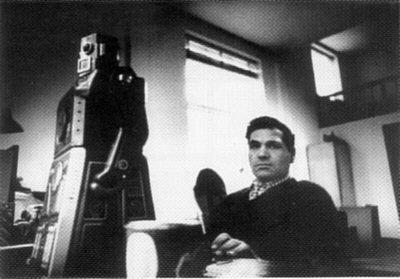Ballard: "[T]he world of the mind, is largely ruled by the laws of fiction, by one's dreams, visions, impressions and so on, and the whole idea of the unconscious as a narrative stage. Surrealism molds the two worlds together, remakes the external world of reality in terms of the internal world of fantasy and fiction. Now what has happened, and one reason why there are no Surrealist painters in the truest sense of the term today, is that this position has been reversed. It's the external world which is now ... the paramount realm of fantasy. And it's the internal world of the mind which is the one node of reality that most of us have. The fiction is all out there. You can't overlay your own fiction on top of that. You've got to use, I think, a much more analytic technique than the synthetic technique of the Surrealists. Eduardo does this in his graphics. He's approaching the subject-matter of the present-day exactly like the scientist on safari.... The environment is filled with more fiction and fantasy than any of us can singly isolate. It's no longer necessary for us individually to dream. It completely cuts the ground from under all the tenets of classical Surrealism."
Ballard: "Eduardo said the other day, that violence is probably going to play the same role in the '70s and '80s that sex played in the '50s and '60s... Although our central nervous systems have been handed to us on a plate by millions of years of evolution, have been trained to respond to violence at the level of finger-tip and nerve-ending, in fact now our only experience with violence is in the head, in terms of our imagination, the last place where we were designed to deal with violence. We have absolutely no biological training to deal with violence in imaginative terms... We sit passively in cinemas watching movies like The Wild Bunch where violence is just a style. Just over a year ago I put on an exhibition of crashed cars, what I called 'new sculpture', at the New Arts Lab. And I had three cars brought to the gallery. It was very easy to mount the show because the technology of moving cars is highly developed... And I had an opening party at the gallery. I'd never seen 100 people get so drunk so quickly. Now this had something to do with the cars on display. I also had a topless girl interviewing people on closed circuit TV so that people could see themselves being interviewed around crashed cars by this topless girl. This was clearly too much. I was the only sober person there. Wine was poured over the crashed cars, glasses were broken, the topless girl was nearly raped in the back seat of the Pontiac by some self-aggrandizing character. The show went on for a month. In that time [the cars] came up against massive hostility of every kind. The cars were attacked, the windows ripped off. Those windows that weren't already broken were smashed. One of the cars was upended, another splashed with white paint."
Paolozzi: "The public's dilemma comes from the fact that they're still looking for ... objects in the fine-art tradition, and it's this kind of object the public usually gets. Most of the American Pop painters fit absolutely into the tradition of, say, post-Corot painting. A Lichtenstein is no more radical than, say, a Manet... How can any Pop painter be said to have had [the impact of Manet], to have advanced beyond that? As far as I'm concerned there's a slight disillusionment with America now; the American dream is over. I think the Olivetti [etchings] take a cool look at a special kind of pornography, the pornography of human values. And in a way, [the work is] forcing people to look at a state they accept, like having monkeys work with computers, and also perhaps suggesting a kind of corporate image, the faceless man: That whole world of Fortune magazine, the whole business language of the American Stock Exchange, the faceless white collar worker turning into a mechanical man. It's not just technology, it's looking with as fresh an eye as possible at the whole realm of human experience."The etchings the artist refers to were commissioned by the British Olivetti Limited company that same year, and were entitled Cloud Atomic Laboratory. All 8 prints can be viewed at the Tate's website:
1, 2, 3, 4, 5, 6, 7, 8.
Spencer, Robin. ed. Eduardo Paolozzi: Writings and Interviews. NYC: Oxford University Press, 2000. 198-207.
First Published in: Studio International, 193 (Oct. 1971), 138-43.


3 comments:
Don't worry about the length. That's some really interesting stuff.
That is really wonderful material. Any place I can view more of this online? As it is hightly unlikely I will be able to find the book out here.
I don't think so. I'm reading the Paolozzi book in bits and pieces, so I'll pass on anything of particular interest on the weblog.
The SF publication Re-Search did a monograph of interviews and excerpts from J.G. Ballard which is excellent. At the end of the month, when I'm in Philly I'll stop by the Tyler library and pick it up.
Post a Comment